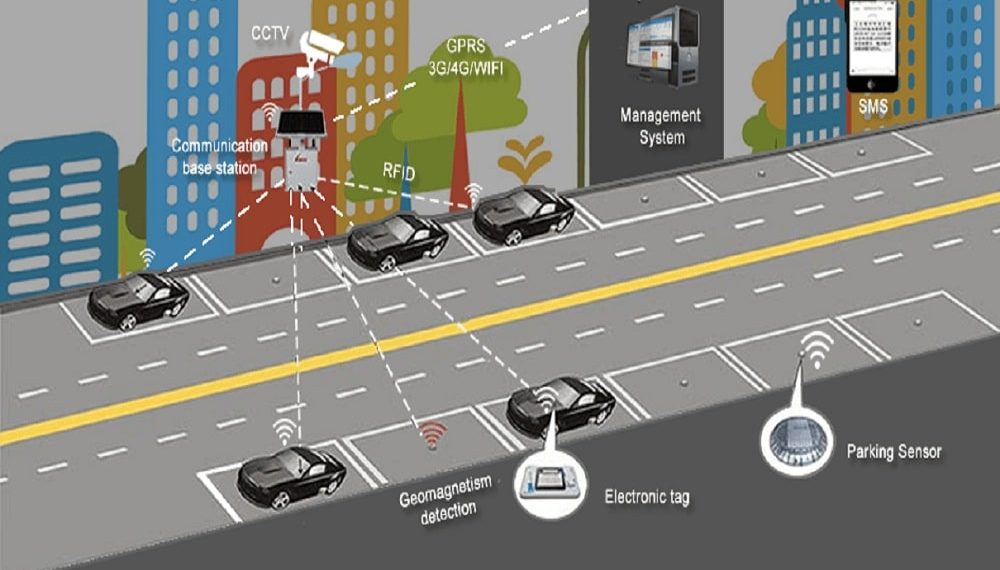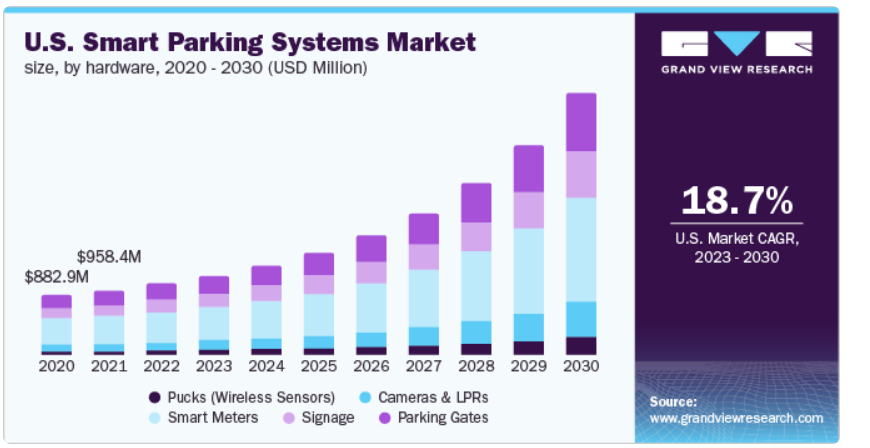Searching for a parking place in today’s crowded metropolitan environments may take time and effort. As a result of the development of Internet of Things (IoT) technology, however, intelligent parking management systems are becoming more popular as a potential solution to this persistent urban problem. This piece will examine the advantages and disadvantages of integrating the Internet of Things IoT in smart parking management.
The complexity of city traffic is increasing daily, particularly after COVID-19, when everyone appears to be out on the road. Urbanization is growing, and the complexity of city traffic is developing constantly. Only some have easy access to public transportation, and parking a personal car is considerably more difficult (and expensive) than public transportation.
Because of this, the need for a parking system driven by the Internet of Things (IoT) has become more critical to decrease parking availability’s unpredictability and lessen continuous traffic congestion. Now that many linked gadgets are on the horizon, it is relatively easy to design an intelligent parking system based on the Internet of Things.
What precisely is an IoT-based parking system?
A parking system based on the Internet of Things (IoT) is a centralized management system that allows drivers to search for and book parking spots remotely using their cell phones. When drivers want to escape anticipated traffic congestion, it provides a suitable arrangement for them to park their vehicles.
The system’s hardware sensors are responsible for identifying available slots and relaying this information to the drivers in that particular region in real-time. The Internet of Things (IoT) technology assures that they will no longer have to worry about finding an available place, enabling them to move comfortably.
In addition, the linked gadget will deliver notifications about peak hours and fees. People prefer to avoid finding a parking spot or paying a higher price at any given time. Through the use of innovative parking technology, it will be possible to optimize the utilization of the parking space that is already available, enhance the efficiency of parking operations, and make the flow of traffic more straightforward with only a few taps on a mobile application.
IoT in Smart Parking
Vehicles equipped with intelligent IoT in smart parking solutions are designed to give drivers complete control over their trip, from the beginning to the conclusion, without needing to search for parking spots. The Internet of Things technology helps reduce travel time and expenditures. It also serves as the basis for collecting and analyzing data in real time.
Through the Internet of Things (IoT), it is possible to link the many sensors and devices that are part of the parking ecosystem and obtain data that can be utilized to improve operations. The combination of IoT technology with autonomous cars is where the future of smart parking rests. As a result of the arrangement, people would have an easier time getting about, which would free up even more room on the roads.
Benefits of Internet of Things-based parking system

Real-time data makes things run more smoothly.
One of the best things about IoT in smart parking management is that it lets you get real-time information on how many parking spots are available. By putting devices in parking spots, cities, and towns can adequately track how many cars use the spaces. Then, this information can be sent to drivers through mobile apps, which will quickly guide them to open spots. A study by McKinsey found that real-time parking data can cut the time people spend looking for parking by as much as 43%.
Most efficient use of space
IoT-enabled parking systems not only make things easier for drivers, but they also make better use of room. Authorities can find places that need to be used by looking at parking habits and demand trends. They can then change the prices or use them for other things. This proactive method can make sharing parking spaces fairer and help relieve traffic in busy places.
Better environmental impact and traffic flow
Reducing the time people spend looking for parking helps cars but also significantly affects traffic flow and the environment. Studies have shown that many traffic jams in cities are caused by people looking for parking. IoT can help reduce traffic jams, lower carbon pollution, and improve air quality by making this process more efficient.
Better security and safety
Other significant benefits of IoT in smart parking management are better safety and security. Real-time tracking lets police quickly find cars that aren’t supposed to be there or strange activities in parking lots. Monitoring systems connected to the Internet of Things (IoT) can also provide helpful proof in the event of crashes or crimes, making cities safer.
Why is an IoT-based innovative parking system a good idea?
Customers often get frustrated with traditional parking systems because they aren’t always clear about availability and prices. Management of parking lots based on IoT has changed the game for everyone. With parking availability information, drivers can now plan their routes. Law enforcement can quickly look at violations. Similarly, parking lot managers can use their resources best with real-time access to parking info.
New parking systems based on the Internet of Things (IoT) solve issues and make payments more accessible. Smart meters are easy to pay for because you can use a credit card or smartphone. The Internet of Things (IoT) also checks every second to see if a car is in the parking lot. This tells the app in real time how many spots are open, so drivers only pay for the time they use.
Let us look at some important issues that IoT-enabled parking systems can successfully attend to:
For better traffic flow:
IoT cameras will properly count and mark the locations of empty parking spots, cutting down on traffic jams. They will also show cars where there are open spots and keep an eye on how much space is left, making traffic move better.
A parking control system uses an Internet of Things (IoT) screen in the cloud to display real-time information about the whole building.
This means better methods and more safety: Built-in sensors monitor how the car moves, making parking safer and faster. Mobile app development also shows real-time information about parking spots and lets users know if security is broken.
Environmental Monitoring in Parking Garages:
To make sure everyone is safe, sensors check the air quality and temperature. Control and manage who can get in. People who want to use parking lots must first be cleared on their phones or have their license plates scanned.
Watching over parking lots:
Putting up video cameras makes watching over parking lots easy. Issues like theft and car accidents can be handled easily.
Parking Reservation:
Drivers can reserve parking spots on the web or their phones, and new technologies like parking locks can make the process easier.
Effective Parking Management:
To improve parking management effectiveness, an IoT-based parking system monitors conditions, checks for open spots, and speeds up the billing process.
Because of this, a new parking system driven by the Internet of Things (IoT) lets cars get information in real time and lets parking lot managers handle and keep an eye on spots from away.
The following IoT-based sensors are often used in innovative parking systems.
- Ultrasonic sensors find out how far away an item is by blocking ultrasonic sound waves and turning the sound waves that bounce back into an electrical signal.
- Metals can be found with electromagnetic field monitoring because they can pick up on small changes in the magnetic field.
- Infrared monitors can pick up on movement and changes in the temperature of the area around them.
Also read: IoT in Agriculture: A Revolutionary Development for the Farming Sector
What Can Go Wrong When You Try To Use IoT in Smart Parking Management?
The market for smart parking is new and has a lot of promise. According to a new study, the smart parking market is expected to grow from $3.8 billion in 2020 to $5.4 billion by 2025. It brings more than $8 billion annually to the US economy through business parking lots and buildings.

However, despite a big market for innovative parking systems, few parking lots have chosen to use them. The slow rate of uptake is due to several problems, such as:
A. Problems with the organization
1. Being aware and accepting
Changing a society that has existed for hundreds of years is a tremendous job. There has always been straight money trade in the parking business. Adding technology to everyday life is a significant change that will take some time.
2. A lot of money needed to launch
When smart parking infrastructure is implemented, capital investments can be very high. For instance, installing the right sensors and IoT devices in a single parking spot can cost more than $1,000. The costs can get too high when you multiply that by the number of parking spots in a building.
B. Problems with technology
1. Accuracy of information
One of the biggest challenges is ensuring that users always see accurate information on the app. If the data isn’t sent correctly or takes too long to arrive, drivers may end up parking in places they’re not supposed to be, which can cause a lot of chaos and confusion on the roads.
2. IoT tools that are easy to get
The service companies handle the very long parking process with the help of computer systems like the P&E PARC and PUCRS. Some examples are computer clients, servers, wireless and wired phone systems, hardware monitors, dynamic message systems, devices that handle traffic, and application interfaces.
To make IoT in smart parking cheaper and easier to use, it’s essential to allow devices from hundreds of companies to talk to each other and connect to a single platform. Putting in an intelligent parking management system is also challenging because many sensors must simultaneously be online to get information for a single booking window. It will take a lot of work for you to have a variety of routers.
IoT in Smart Parking- Future
Using new technologies like AI, self-driving cars, and virtual reality to make the best use of room, improve user experience, and support sustainability is what innovative parking management will be all about in the future. AI programs will change prices and supply on the fly, self-driving cars will find their way to specific locations independently, and virtual reality directions will make things easier to understand. Multi-modal integration will support environmentally friendly transportation choices, and programs to protect the environment will prioritize eco-friendly cars and keep an eye on air quality. This coming together of new ideas will completely change how people get around cities, making parking faster, easier, and better for the environment.
Conclusion
In conclusion, combining Internet of Things (IoT) technology with innovative parking management is an excellent way to solve the problem of finding parking in busy cities. IoT-enabled parking systems help drivers and parking lot managers by giving them real-time information on available parking spots, making the best use of space, and improving traffic flow. However, IoT has yet to be widely used in intelligent parking management because organizations aren’t ready for it, the initial investment costs are high, and the technology is hard to understand.
Despite these problems, AI, self-driving cars, and virtual reality are making huge strides that will significantly impact the future of intelligent parking management. These advances will improve the user experience, use resources better, and support environmental sustainability. IoT in smart parking management will be a big part of the future of urban movement as towns adopt these new ideas and get past the problems that are stopping them now. It will make parking faster, easier, and more efficient for everyone.




